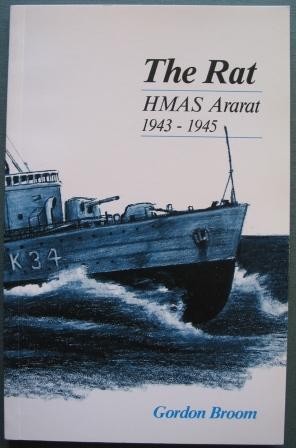An account of life on board one of Australia’s Corvette class anti submarine patrol and escort ships during World War II through the eyes of Telegraphist Gordon Broom “Junior”. Now a scarce RAN ship history title.
HMAS Ararat (K34/M34), named for the city of Ararat, Victoria, was one of 60 Bathurst class corvettes constructed during World War II, and one of 36 initially manned and commissioned solely by the Royal Australian Navy (RAN).
Ararat is the only ship of the Bathurst class to carry a pennant number with the flag superior ‘K’: to honour Flower class corvette lead ship HMS Gladiolus, which was sunk in October 1941.
Ararat entered active service in August 1943 escorting convoys firstly along the east coast of Australia, and later between Queensland and New Guinea. She continued in this role until March 1944, when she was transferred to Langemak, New Guinea for two months, performing escort and patrol duties in the waters of New Guinea and New Britain. During this time, she was the first ship of her class to visit several recently-recaptured areas in New Britain.
The corvette was under refit in Melbourne from May until July 1944, and on completion returned to New Guinea. She was transferred to United States Naval command on 11 August 1944, and was used to patrol the forward areas of the Allied offensive. During this time, Ararat was involved in the transportation of survivors from sister ship HMAS Geelong following her collision with United States tanker York on 19 October. Ararat left US command at the end of 1944, and spent the early part of 1945 operating in the Morotai area. She briefly visited Townsville in March 1945, and in June, the corvette was deployed to Borneo to support Australian troops. Ararat returned to Australia on 22 July for refits, and was in dock when the war ended. The corvette’s wartime service was recognised by the battle honours “Pacific 1943–45” and “New Guinea 1943–44”.
Ararat was assigned to the 20th Minesweeping Flotilla on 22 October 1945, and was involved in clearing mines laid during the war; first in Australian waters, then around New Britain, New Ireland, and the Solomon Islands. This assignment was completed in November 1946, and on 11 April 1947 was decommissioned into reserve.
Ararat remained in reserve until 6 January 1961, when she was sold to Burns Philp & Co Ltd of Darwin. pp. 93 illusts Signed by Author. (inscription)#0520/060724
